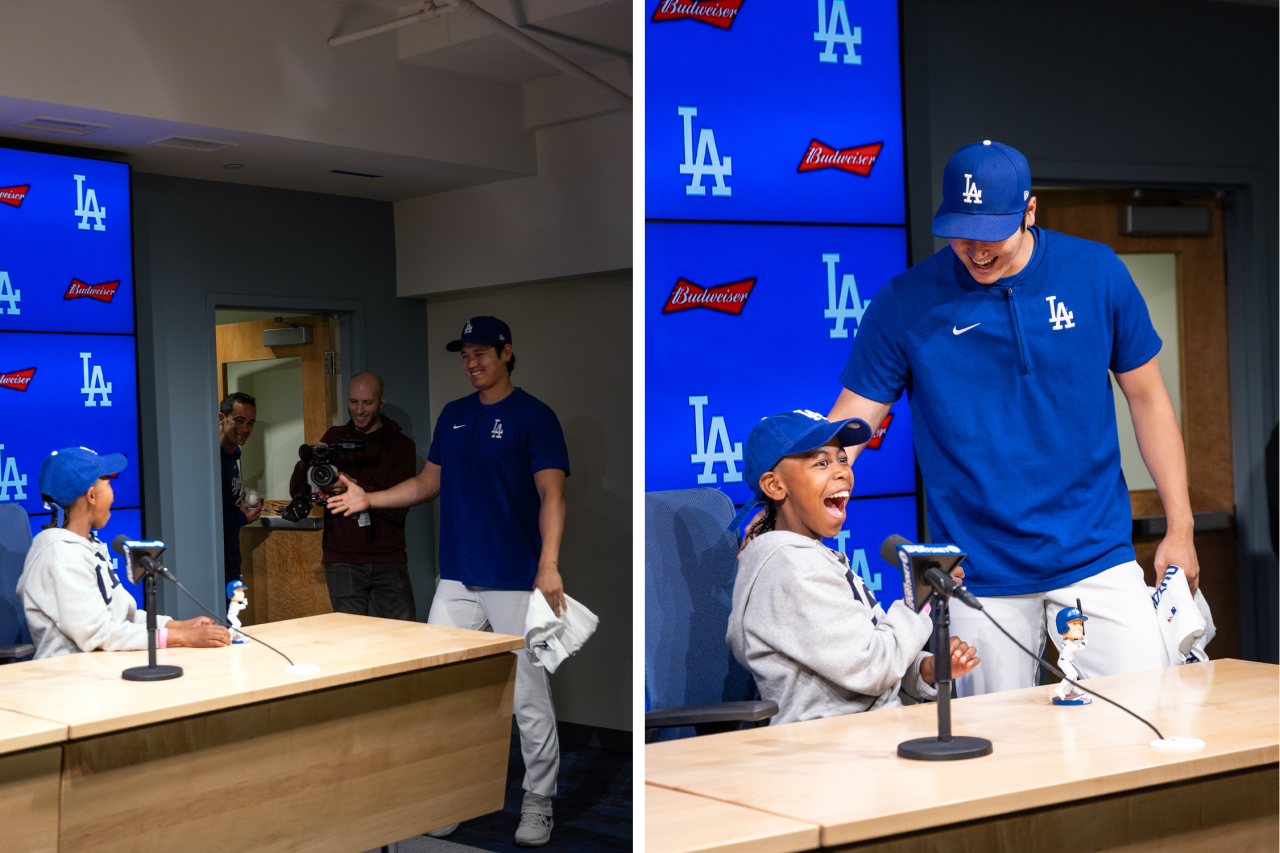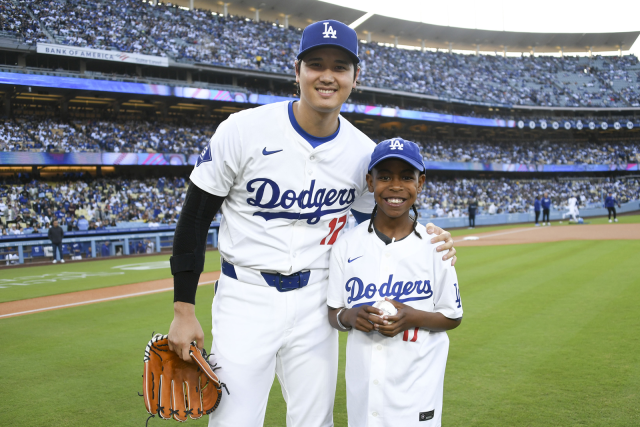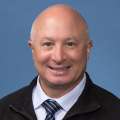The first surprise for 13-year-old Albert Lee was tickets to a Dodgers game. The Little Leaguer, who has been treated at UCLA Health since birth for a congenital heart condition, is a big fan of Dodgers superstar Shohei Ohtani.
Albert’s second big surprise was discovering he was coming to Dodger Stadium on May 16, Ohtani bobblehead night, when 40,000 fans take home a collectible of the star slugger. The giveaway attracted more than 53,000 attendees.
But Albert had no idea about the surprises yet to come.
He didn’t know that Ohtani had requested a pediatric patient from UCLA Health be chosen to throw out the first pitch that night, nor that pediatric cardiologist , recommended Albert for the honor.

Albert was just excited to come to the game. His mother, DeJanee Johnson, wanted to let the surprises for her son unfold throughout the night, making for an unforgettable evening for the entire family.
Jaw-dropping delight
Wearing a blue Dodgers ballcap and toting his new Ohtani bobblehead, Albert encountered surprise No. 3 about three hours prior to the game: a VIP tour of the stadium, which brought him and his family into the Dodgers’ trophy room. He posed for photos amid the team’s collection of Golden Glove awards and World Series trophies.

From there, it was off to the press room, where players field questions from reporters. Albert sat on the dais, his now-unboxed bobblehead in hand, taking questions from his family members and Dodgers and UCLA Health staff.
Favorite ballpark snack? Dodger dogs. And nachos.
Favorite position to play? Hitting and outfield.
Classes he’s most looking forward to when starting high school next year? Engineering and marching band.
Favorite dance move? The worm.
He was at the center of this playful, pretend press conference when Ohtani suddenly walked into the room. Albert went silent. His jaw dropped.


“Nervous?” Ohtani said, a warm smile on his face.
Albert said nothing. “I couldn’t breathe for like 30 seconds,” he later shared.
Ohtani pulled out a jersey and autographed it for Albert. Still speechless, his eyes widened.
“Thank you for coming tonight,” Ohtani said. “Are you ready? You’re going to throw (out) the first pitch.”
The international superstar handed Albert a baseball. The boy’s jaw dropped again.

Finally, after whispering an awe-filled “thank you,” Albert’s family urged him to say something to his favorite player.
“How far was your home run against the Giants the other day?” the 13-year-old asked.
“Four hundred forty-something,” Ohtani said of the 446-foot blast.
Dodger staffers then dropped another surprise: Albert and his family would be watching the game from a private suite, where they could relax and have snacks before taking the field for the first pitch. Albert’s eyes said, “I don’t believe this!” His mouth said nothing.
As Ohtani left for pre-game warm-ups, he tapped the brim of Albert’s cap and said, “Good luck!”
“What the heck just happened?” Albert said as the All-Star walked away.
And still, another surprise awaited.
A journey of healing
Albert looks like a healthy, 13-year-old kid, but he was born with essentially half a heart – only one ventricle instead of two – a condition known as Hypoplastic Left Heart Syndrome. He needed open-heart surgery as a newborn, less than 2 weeks old. A second open-heart surgery followed a few months later, and a third when he was 3.
These surgeries created pathways for Albert’s heart to function with just one ventricle, said Dr. Satou, who has been caring for Albert since he was 13 days old. While he will require medication and cardiac surveillance throughout his life, the doctor said, Albert can otherwise live normally like any other teen, except for participating in high-intensity sports: “You wouldn’t know he has any heart problems, unless he picked up his shirt and you saw his long scar down his chest.”
“Albert has handled his heart condition with grace,” his mother said before the game, her eyes welling up. “He’s been able to realize the seriousness of his condition … and be cautious about how he lives life, but still soak up every moment.”

There were plenty of scary and traumatic moments during Albert’s earliest days, Johnson said, and sometimes it’s still frightening. But Dr. Satou and the UCLA Health pediatric cardiology team have provided constant support, she said.
Albert is healthy and thriving, which makes their once-in-a-lifetime Dodgers experience even more meaningful.
“It means everything. It means I followed the directions from UCLA correctly. It means my mother instincts are working,” Johnson said. “To see the shock in his eyes and the joyfulness in his face, he was so happy. I’m excited and blessed to be able to see him get that experience.”

Dr. Satou also came to Dodger Stadium to celebrate Albert throwing out the first pitch and greeted him with a hug.
“Your friends are going to be jealous,” he said. Albert beamed.
Taking the field
Just before gametime, Albert, now wearing his signed Ohtani jersey, along with his mom and little brother, were escorted to the field. Albert insisted he wasn’t nervous about throwing out the first pitch, and once he started warming up on the field, it was clear why. He made a solid throw, right down the middle. He practiced with a couple of uniformed players before his big moment.
“Like playing catch,” his mom called to him as Albert took the field.

A voice boomed over the stadium loudspeaker: “Dodger fans, Shohei Ohtani has chosen to commemorate his bobblehead night at Dodger Stadium by inviting a very special guest for the ceremonial first pitch: It’s 13-year-old Albert, a pediatric patient at UCLA Health.”
“Woo!” his mom shouted from the sidelines.
Albert stepped up to the mound. The crowd cheered.
Just as he was winding up to throw, out came a final surprise. Unannounced, Ohtani took the field, crouching in the catcher’s spot. The audience roared.

Albert sailed the ball toward home plate, right to his idol.

